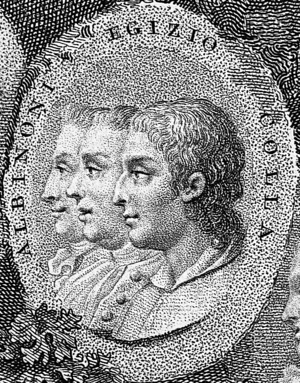Tomaso Albinoni facts for kids
Tomaso Giovanni Albinoni (born June 8, 1671 – died January 17, 1751) was an Italian Baroque composer. The Baroque period was a time in music history from about 1600 to 1750. Albinoni wrote many different kinds of music. These included operas (musical plays), concertos (music for a solo instrument and an orchestra), and sonatas (music for one or a few instruments).
While he was very famous for his operas during his lifetime, today he is mostly known for his instrumental music, especially his concertos. He is also remembered for a piece called "Adagio in G minor". However, many people believe this famous piece was actually written by Remo Giazotto. Giazotto was a modern music expert who studied Albinoni's works.
Contents
About Albinoni's Life
Early Years in Venice
Tomaso Albinoni was born in Venice, Italy. His father, Antonio Albinoni, was a wealthy paper merchant. Tomaso learned to play the violin and to sing. Not much is known about his life, which is surprising because he was so well-known as a composer back then.
In 1694, he dedicated his first collection of music, called Opus 1, to Cardinal Pietro Ottoboni from Venice. His first opera, Zenobia, regina de Palmireni, was performed in Venice in the same year.
Musical Career and Independence
Around 1700, Albinoni might have worked as a violinist for Charles IV, Duke of Mantua. He dedicated his Opus 2 collection of instrumental pieces to the Duke. In 1701, he wrote his very popular Opus 3 suites. He dedicated this collection to Cosimo III de' Medici, Grand Duke of Tuscany.
In 1705, Albinoni married Margherita Rimondi. He became famous for his operas in many Italian cities, including Venice, Genoa, and Naples. During this time, he also wrote a lot of instrumental music. Before 1705, he mainly wrote trio sonatas and violin concertos. But from 1705 to 1719, he started writing solo sonatas and concertos for oboe.
Unlike most composers of his time, Albinoni never seemed to work for a church or a royal family. This was because he had his own money and could afford to compose music on his own. In 1722, Maximilian II Emanuel, Elector of Bavaria, invited Albinoni to direct two of his operas in Munich. Albinoni had dedicated a set of twelve concertos to Maximilian.
Later Life and Death
Around 1740, a collection of Albinoni's violin sonatas was published in France. It was mistakenly called a "posthumous work," meaning it was thought to be published after his death. For a long time, people believed Albinoni had died by then. However, records show that Tomaso Albinoni actually died in Venice in 1751. He passed away from diabetes mellitus.
Albinoni's Music and Influence
Most of Albinoni's operas have been lost because they were not published during his lifetime. However, nine collections of his instrumental music were published. These were very successful and were printed many times. Because of this, he is mostly known today for his instrumental music. He wrote 99 sonatas, 59 concertos, and 9 sinfonias.
During his life, his music was thought to be as good as that of famous composers like Arcangelo Corelli and Antonio Vivaldi. Albinoni wrote at least 50 operas, and 28 of them were performed in Venice between 1723 and 1740. He even claimed to have written 81 operas!
Oboe Concertos
Even with so many operas, Albinoni is most famous for his instrumental music. His oboe concertos are especially well-known. These include pieces from his Opus 7 and, most famously, his 12 Concerti a cinque Opus 9.
Albinoni was the first Italian composer known to use the oboe as a solo instrument in concertos. He published these works around 1715 in his Opus 7. Other composers like Telemann or Händel from Germany might have written oboe concertos earlier. In Italy, Alessandro Marcello published his famous oboe concerto in D minor a little later, in 1717. Albinoni also used the oboe often in his chamber music and operas.
Influence on Bach
His instrumental music was very important to Johann Sebastian Bach. Bach was another famous composer. He wrote at least two fugues based on Albinoni's musical ideas. These are called Fugue in A major on a theme by Tomaso Albinoni (BWV 950) and Fugue in B minor on a theme by Tomaso Albinoni (BWV 951). Bach also often used Albinoni's bass lines to teach his students about harmony.
Sadly, some of Albinoni's music was lost during World War II. The Dresden State Library, where some of his works were kept, was destroyed. Because of this, we don't know much about his life and music after the mid-1720s.
The Famous Adagio
The well-known Adagio in G minor is a piece that many people have recorded today. Some believe it is a musical hoax created by Remo Giazotto. However, a music expert named Muska Mangano, who was Giazotto's last assistant, found something interesting. Among Giazotto's papers, Mangano found a modern copy of the figured bass part of the music. She also found six small parts of the first violin section. These pieces had a stamp that clearly said they came from the original music in Dresden. This discovery supports Giazotto's claim that he based his composition on an older, original source.
See also
 In Spanish: Tomaso Albinoni para niños
In Spanish: Tomaso Albinoni para niños



